Phillips Auction November 2021
Posted on |
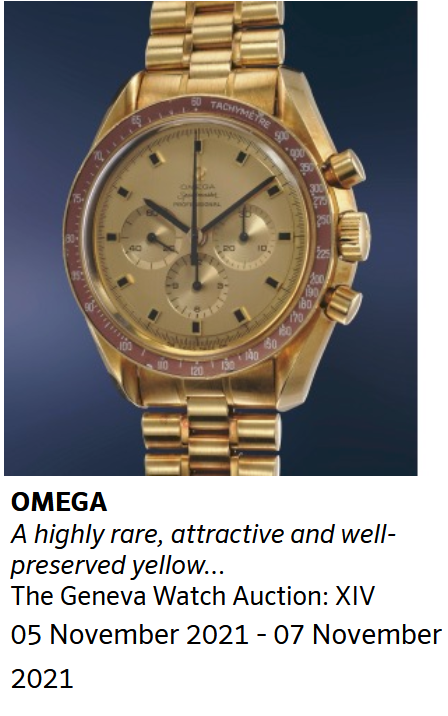
Sold for $48,200
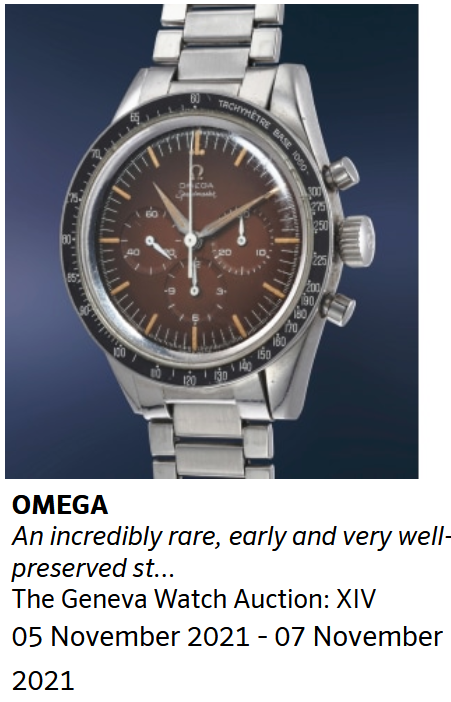
Sold for $110,200
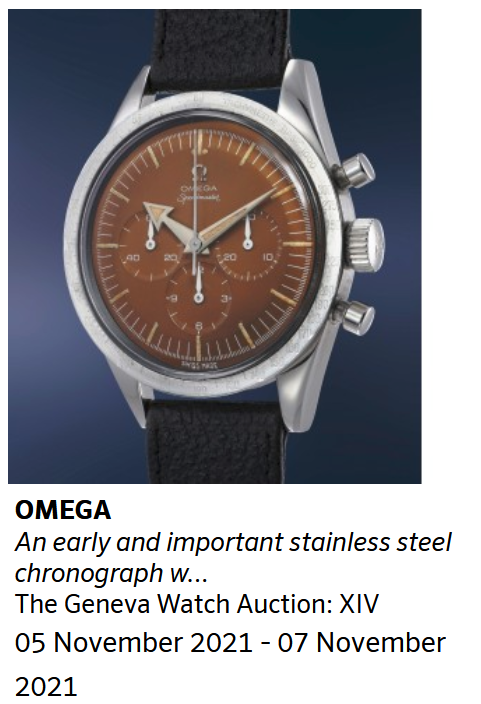
Sold for $3,400,000
(not a typo)
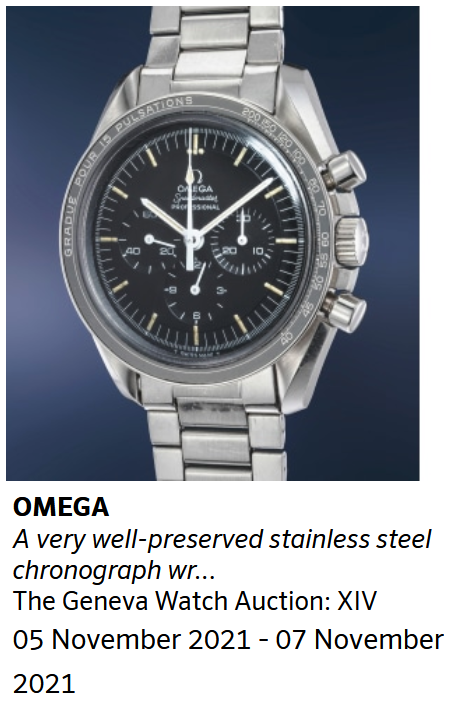
Sold for $22,000
Absurd
Phillips are offering four Speedmasters in their Geneva Sale, November 5th and 7th 2021.
This House is really strong in my opinion, and pushing themselves to find watches that look interesting. They also seem to be pitching the estimates reasonably for the most part. There is a crazy one here, but one in four isnt bad. I think a physical viewing of this sale will be educational. I am not connected in any way to the House or the watches – other than I would quite like to own some.
Things to remember about all auctions houses:
The commission: Phillips will charge 26% on top of the winning bid. So for example a bid of $50,000 will cost you $63,000 (on lot 49 perhaps). Or if you bid 100,000 on lot 51 it’s actually going to cost you $126,000.
Also Swiss residents will pay some local taxes, overseas buyers will have to ship and pay their countries import charges. Auctions are not the cheapest way to acquire a watch, but they do work hard to try and find a watch that you might not be able to.
Phillips Listing:
Lot 49
Ref. BA 145.022
A highly rare, attractive and well-preserved yellow gold limited edition chronograph wristwatch with solid gold “Oval O” dial, burgundy bezel, engraved back and bracelet, number 298 of a 1014 pieces limited edition
1969
40mm Diameter
Case, dial, movement and bracelet signed
Estimate
CHF25,000 – 45,000
€23,100-41,500
$26,700-48,100
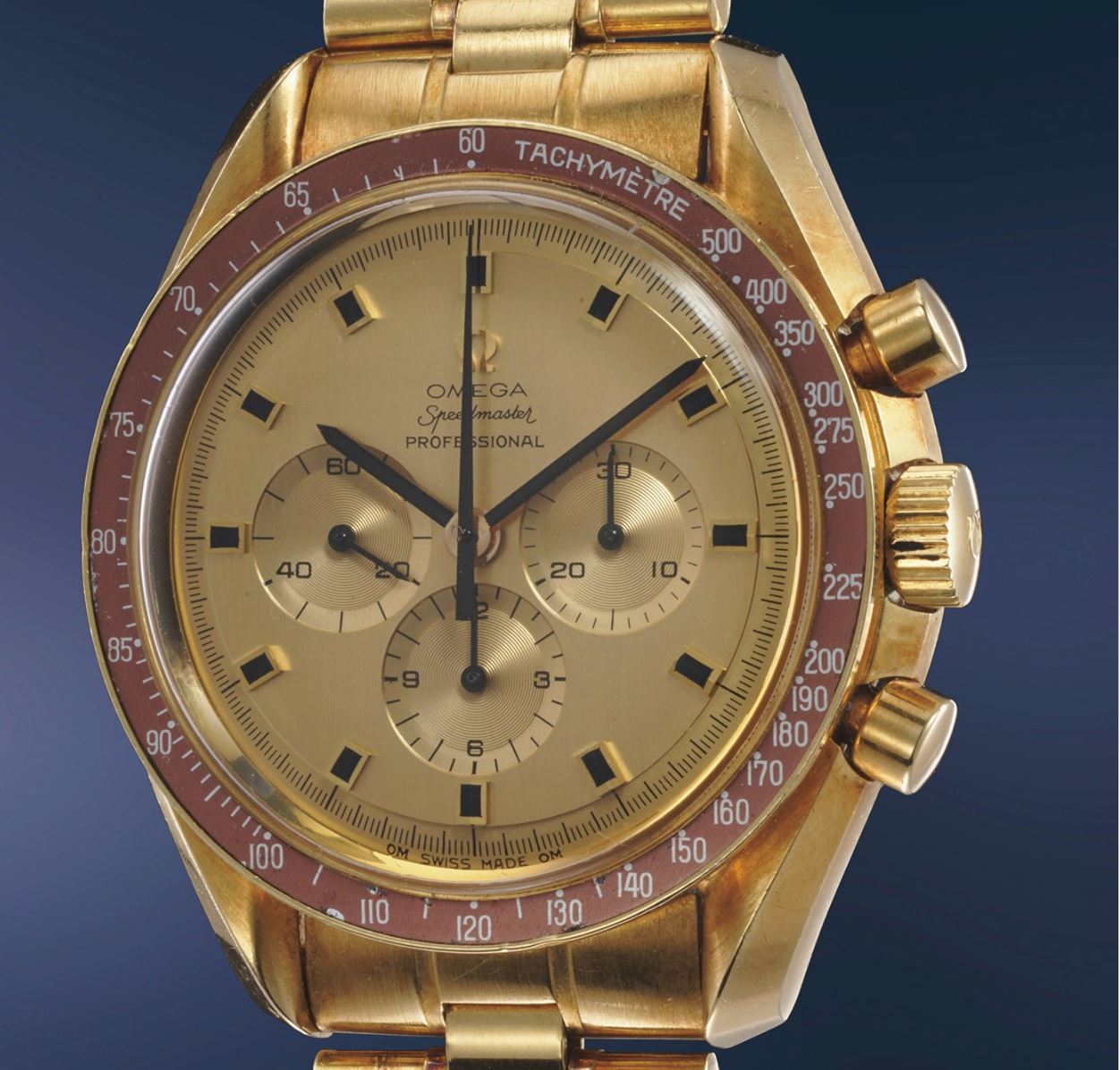
I love these 1969 Speedmasters. Limited to 1014 pieces, it was Omega’s first limited edition speedmaster – yes all that Limited Edition nonsense (As my non Omega, Rolex friends call it) started here.
I assess these slightly differently than a steel Speedmaster, as the first thing I look at is the bezel, as without the DO90 burgundy bezel the value of the watch is held back. Then I make sure the dial is correct “OR MASSIF”. Then I check for the presence of a bracelet, as they all came with a bracelet. Finally, I check the case for wear – 18kt cases can get quite worn quickly in use, or polished and blurred.
This watch has got a pretty good DO90 Burgundy bezel. It has two easily noticeable chips, and some minor black marks, as well as evidence of damage to the carrier ring. As these bezels go, this is definitely in the upper condition group. One thing that does make me wonder, is does the bezel condition match the watch, and could it have been added later. It just seems the bezel has been through more than the case, but in hand inspection will confirm, and these Burgundy bezels do appear to be fragile, so may easily display age that doesn’t show in the case. This wandering thought of mine about the originality makes no difference to the value — it is the correct bezel in desirable condition. Omega do supply a service bezel for this reference, but it has the DN90 layout. There is also a black version, and I suspect some owners changed their burgundy bezel for a black one, preferring the colour. This would be long before the interest in these watches was high.
Now we look at the dial – and again this is the correct dial. Not only correct, but it has the oval O which I prefer. From my observations, I cannot say with certainty that early watches had an oval O and later a round O. I have seen both combinations.This is an early watch, and has the Oval O. The rest of the dial is in excellent condition. I have seen dials decay, but usually on well-worn examples. The dials are all 18kt gold. This dial is perfect.
The 18kt case is soft, by its nature, and so any wear by an owner is going to leave more evidence than on a steel case. Often these watches have serious scratches or damage, but this one does not seem to have any. In fact this also has slight tarnishing, which is a plus sign to me as it shows it has not been polished, at least for a while. I don’t think this one has been polished at all. It’s very hard to keep the profiles and edges while polishing an 18kt case.
Then I look at the rear of the watch to see which style of engraving we have, and in this case it is the “Apollo” engraving most commonly seen. Some have the smaller specialised engraving similar to the ones given to the astronauts, but this is very unusual.
Finally, I always check the bracelet. There is more than one execution of the bracelet, and every watch was issued with a gold bracelet. We have to make sure it is long enough, otherwise it is going to be an expensive extension as they need to be sized by a jeweller, who may have to hand make a link. I know this as I have done it. You cannot simply size it in the normal way by removing pins, it doesn’t work like that. This bracelet is 205 mm or 8 inches, which is long enough to make me think it is full length from the factory.
It is no 298, relatively low in the series of 1014. I do not know why I like the idea of the early number, but I do.
As for the estimate? Well I think it is conservative. Recent sales by Phillips have all been in the area of $50-65,000 though one sold for $37,000 in HK with a poor bezel, and right in the middle of COVID. One of the auction houses was seeking a private sale for one, with its papers for $100,000, but I do not know if it sold. This example being offered is superior to all the ones listed here.
I like this watch.
Including premium the estimates in USD are $33,600 to $52,300
Comparables from Previous Phillips Sales:
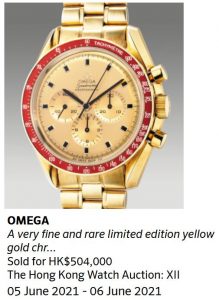
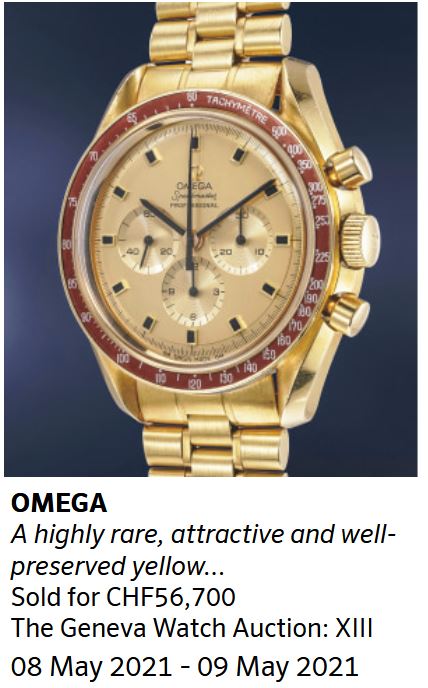
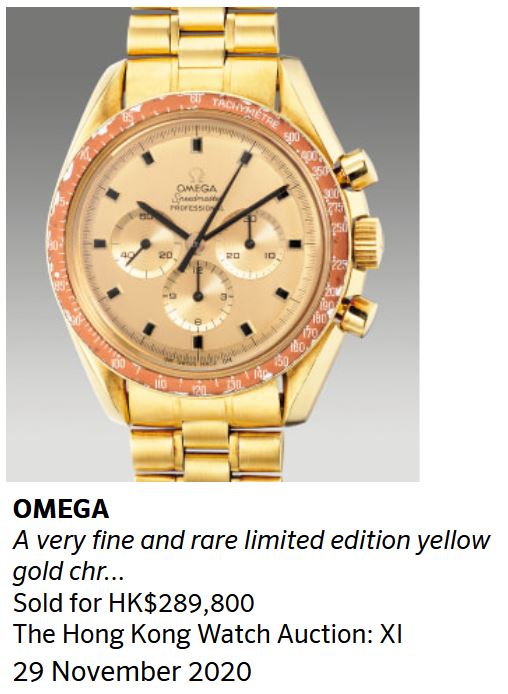
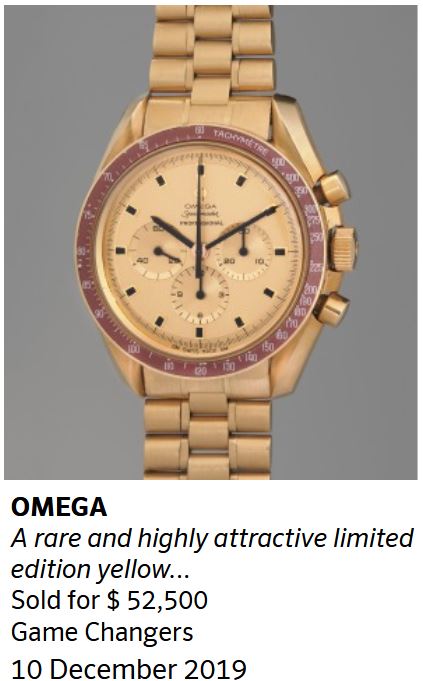
Lot 51
Ref. 2998-1
An incredibly rare, early and very well-preserved stainless steel chronograph wristwatch with chestnut colored “tropical” dial and bracelet
1959
39mm Diameter
Case, dial, movement and buckle signed
Estimate
CHF50,000 – 100,000
€46,100-92,200
$53,500-107,000
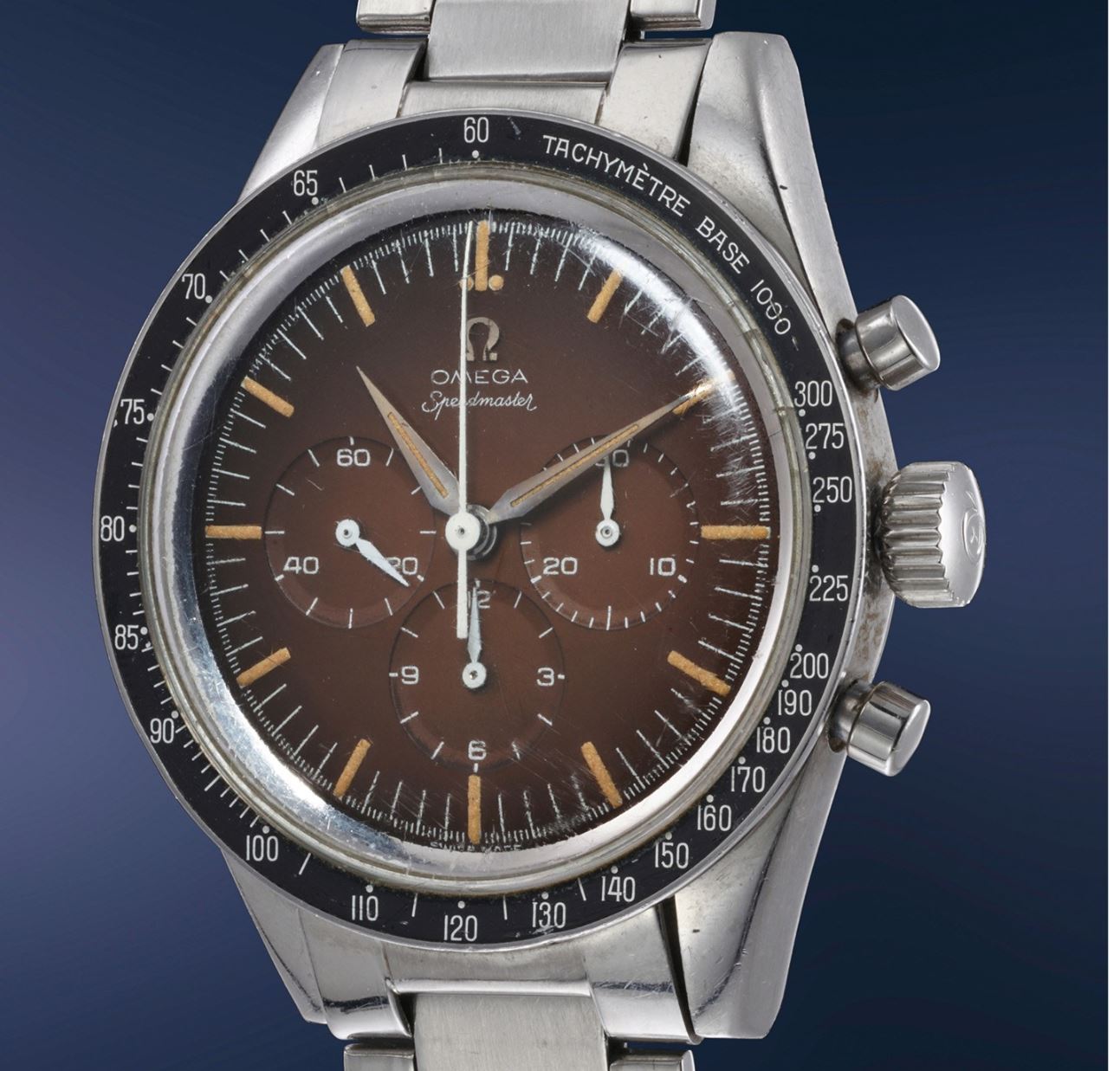
This watch also is immediately striking as an attractive example of this rare reference.
The first things to check on a 2998-1 is for the dial, then the black BASE1000 bezel. Often they lose the BASE1000 and are seen with a later DO90.
In this case the dial is an Oval O, domed, short indices on subdial, the most desirable configuration.
The dial is the heart of the value here. That beautiful brown colour makes a huge difference to the value. What we need to inspect is the dial surface for any blemishes, and it would be unusual if the dial is free of them. In this case the dial is indeed remarkably free from damage, and the only things I can see are slight loss of paint in the subdial rings. I cannot see scratches or oil stains usually seen in these old brown dials. It is a fantastic body colour and in great condition. Then we look at the dial markings, and the white print is in very good condition, and again I cannot see blemishes. It is possible that this dial is excellent, and if so the watch will be fought over.
Now we go to the plots, and as ever the big discussion will be to the condition and originality of the lume. As a 2998-1 we expect both the plots and the lume on the hands to be radium, and it is a test that many buyers will be performing at the physical viewing. The trouble is, a simple Geiger test will just inform us of the presence of radiation, not who put it there or where it is. A spot placed on the back of the dial for example will show radiation even if there is none in the dial or hands. As to my gut instinct, I might say the plots could have been re applied, or adjusted. The colour is uniform and clean. But then so is the dial. This is always the dilemma with fine watches — they look so good, it’s hard to tell if they are polished or relumed. In summary, I have to say I feel unqualified to comment on the originality of the plots. I know several better informed people in the Speedmaster community who will have an opinion, and I will look to them for guidance regarding the lume. I am not sure this dilemma will cause any pause to potential buyers. I am personally on red alert for lume as I am trying to learn.
The next thing I check with this reference is the Alpha hands. What I consider the most desirable, and therefore most valuable, is the triangular lume slots with a transverse curve. Unfortunately this one is straight lume slots. I see many different examples of thin lume slots, some of which are obviously old and original, and others which stop and make me ask questions. In this case, I am asking are those lume slots square ended, and are the hands transverse curved. Interestingly it is possible that these Hour and Minute hands do not show the same characteristics, and therefore may not be a pair. Note the hour hand has curved ended slots, and an easily discernable transverse curve. The minute hand has square ended slots, and if there is a transverse curve, it is not so easy to discern. The lume matches perfectly and given that fact, it is most probable in a watch of this age the lume has been re applied, but this is not certain.
The short answer is that even if one or other of these Alphas are modern, or replaced service hands adjusted and patinated to look old, the difference in value is around 5-10% of the total. In view of the rest of the watch, I can live with that query and move on.
Now the BASE1000 bezel. These are so rare, and the condition of this one is very impressive. It is black, not faded and only minor blemishes. IT is worth a small fortune on its own. I know collectors who would swap and Ed White for this bezel. Imagine, a rare whole speedmaster for that ring of metal. Obviously we must establish it is real before allocating such a huge value to it, but how? I have a small library of non omega produced bezels, including BASE1000’s and while none have approached the originals, I feel it is a “yet”. In this case the bezel does not throw any red flags, and on very close inspection it carries all the characteristics of an old original bezel.
The mid-case is a little blurred, and while on its own, if it fits the rest of the watch I accept it because of the other assets like the dial and bezel. This watch was made in 1960 so its hardly going to retain its sharp lines. Indeed, if it had, that would make me more suspicious. Things to check on the case, that I cannot, is for corrosion, and for the alignment notch between the 12 o’clock lugs.
Something strikes me as odd on the case back, but it is perhaps the photos. However, a buyer would be wise to check the dimensions of the seahorse circle to check polishing has not reduced it, and that the finish is acceptable. I cannot tell from the photos if it has been polished or refinished. The engraving is unusually clear, but that may be the photographer trying to show it off as best he can. The catalogue emphasises that the case back is in fantastic condition, so I am sure there is nothing to worry about, but as a buyer I would want to see this in hand. What I am curious, is to see if the condition of the case back matches the condition of the midcase. It would be hard to explain an original watch having a case back with perfect original lines while the mid-case has lost considerable definition. I think this issue will be resolved on viewing, but if it is the fact that the case back condition does not match the condition of the mid-case, we have an issue.
Finally, the bracelet, is I am sure a 7077 as I can see double size stretch links. The catalogue does not mention this, unfortunately. The No 6 endlinks are very flat and clean. It will be illuminating to see the condition of the bracelet – the amount of wear it has – and see if it matches the endlinks. Judging by the endlinks, I would expect the bracelet to be almost unused – which is suggests condition miss match issue or the bracelet was not worn with the watch, as the case is so worn.
As always with these auction houses, we have to look at the watch as a whole and try to feel how original, how much of the watch and bracelet is as it was when it left the factory. My position is to believe nothing I am told, until the evidence in the watch suggests it could be true. There is so much money now in these watches, that there is motive to deceive. Not only might the buyers try to deceive us, the buyers, but also deceive the Auction staff – who in my experience are not bad or dishonest, rather they are doing the best they can to sell as much as they can correctly. No auction staffer has the in-depth knowledge of certain watches like an obsessive collector, and sometimes things get past them.
In this case, what bothers me is the very clean case back, and the worn mid-case. The miss matching Hour and Minute hands, and the very clean No 6 endlinks.
Now, here is the ironic thing – none of these worries stops me wanting to buy this. Why? Because is is a fabulous example of a rare reference. The brown dial is amazing, even if the plots are adjusted (and they may not be). The hands are no big deal. The possible miss match between the case back and the mid-case may just be my imagination looking for issues – which by the way on a $100,000 watch we should be searching for these issues. It’s not the fact that it has them, it is the fact that before I try to buy a watch like this I need to know what might be wrong, what I might discover in ownership so that there are no surprises after I have paid. For me it’s fine to buy this watch knowing there are issues, for example, that the hour and minute hands do not match and may have been added later. What is not fine is to buy it thinking they are original, and discovering later on disassembly the hands are clearly not part of a pair.
In summary, I like this watch. It’s an amazing dial, with a BASE1000 bezel, and it is a dash 1.
The estimate is $50 to $100. If there is money in the room, that is not bothered by what I see, I think it will break the high estimate. If there isn’t, it might come to me, because at the low estimate I love this watch, issues and all. Below are four examples of 2998’s sold by Phillips.
Comparables from Previous Phillips sales:
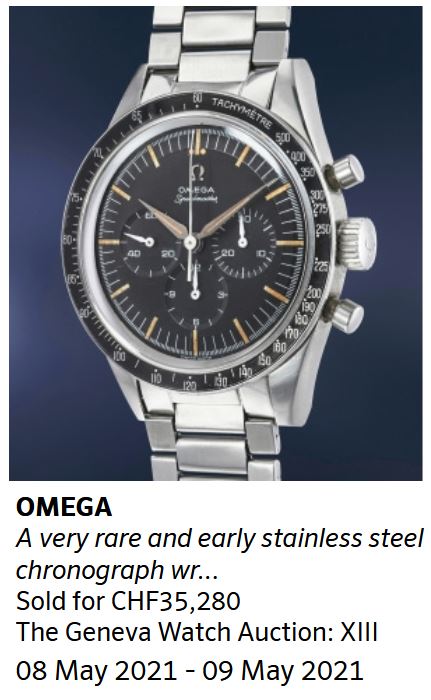
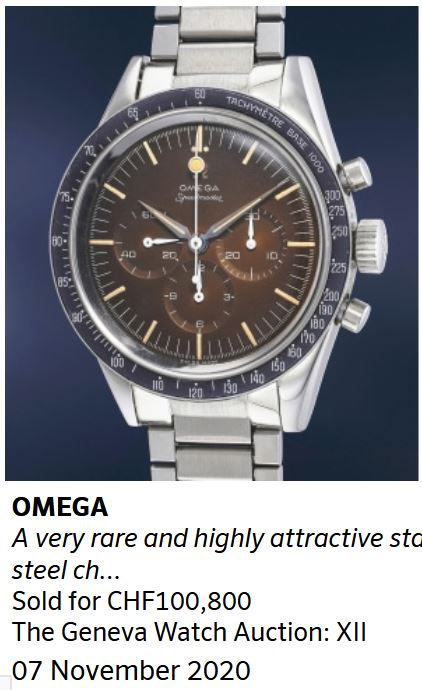
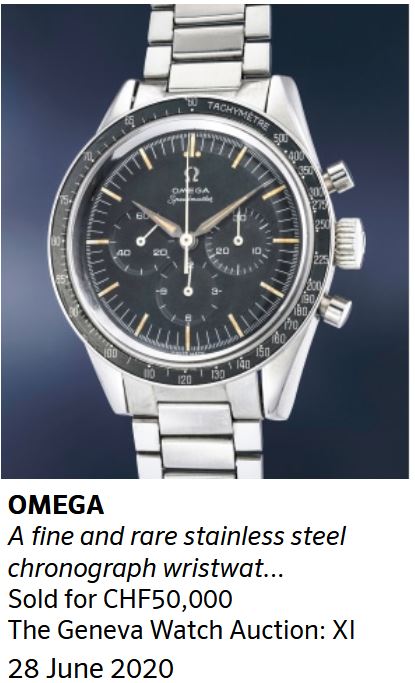
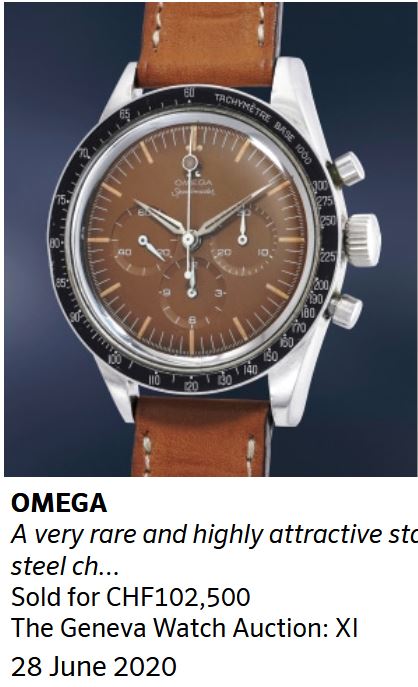
Lot 53
Ref. 2915-1
An early and important stainless steel chronograph wristwatch with Broad Arrow hands and chocolate brown “tropical” dial
1957
38mm Diameter
Case, dial, movement and buckle signed
Estimate
CHF80,000 – 120,000
€73,800-111,000
$86,200-129,000

A 2915 is always going to be interesting and spark plenty of discussion.
A 2915 without major issues estimated at under $100,000 will always attract a lot of attention.
A brown dial as well? This watch is going to get a lot of bidders, I think.It is true that prices have come down since the $400,000 achieved in 2018 but this is a spectacular watch. And I want it.
I must admit, I am not the most knowledgeable of 2915 collectors. I bow to several others, but I will do my best here and explain my thinking. First as always the dial.
This dial appears correct, oval o, short subdial indices, and domed. I would expect a positive reading on a Geiger counter for Radium. The body colour is another extraordinary brown, this time caramel brown, most attractive. As for the quality of the body, it is largely without blemish except an obvious scratch on the lower subdial, and this might grow to bother some owners. Grow in the mind’s eye, that is. I would expect in real life to be able to find some other minor marks with a loupe, that are not confirmed in the photos.
Moving on to the print, that is all good and present, no damage. The plots are decayed, and may have been adjusted. They look quite lumpy and uneven, but I am not the expert in this. I cannot really tell just from a picture, and frankly I don’t think anyone can be 100% certain unless they did it themselves. For me I take a view, and ask myself do I like it? Does anything jump out as relume? Does anything make me feel uncomfortable? It’s very hard with the lume plots on these expensive watches. Always have to remember it’s as though if you dismiss a watch like this for fear of a relume that there will be another along next week without the same worries. You have to take a view. Do you want the reference, or not? If so, we have to pony up and take a risk – with as much knowledge as we can. Always with the proviso, do we find it attractive, and I do.
In this case, a lume query would not stop me buying at this level.
Now we look at the bezel. There are rumours of NOS original bezels sitting in retired watchmakers safes that collectors have a standing offer of over $50,000 for. It’s one thing to say it, but I am not sure I wouldn’t rather have the $50,000 and track down one of the “German” reproductions at $4000. All that said, a genuine metal bezel might well be fought over if offered at $20,000. The point is we have to be happy with the bezel, and have an idea of what we think of it so as to allocate value when determining what we think the watch is worth, or might fetch.
Is this a real bezel? I have no idea, none at all. Nor do you.
Here are some random thoughts. There is a collector who firmly states that all 2915-1’s came with a bezel, where the “3”’s are all flat topped. This bezel is round topped and is similar to the bezel fitted to the $400,000 2915-1 sold in 2018. I do not have an opinion on this matter, as I have not observed enough 2915’s to know. I have always said that as the makers of the replacement bezels become more skilled, it is only a matter of time before they are undisguisable from the originals. At that point they all become worth the same, that is the price of the replacement, and so that is how I think. Unless the bezel has something about it that really makes me believe it’s old, then I have to start by allocating the value of the reproduction. I know many will disagree with my method – which is fine, you use yours and I use mine. Last thing to say is I sometimes look at a 2915 and its bezel, and I say to myself, it looks, feels and smells right. I will pay more for that, but I can’t tell you a hard fact why.
The hands: another area of knowledge I am sorely lacking in, due to lack of exposure to confirmed original examples. I would say I have seen several examples of hands with slight variations, some said to be service hands from the 1070s and some to be variations on original hands. I must say I think the “Service hands from 1970s” might be a euphemism for Vietnamese reproductions, but that might just be my jaded scepticism. What I do know is that they have transverse curves, radium lume and are very often relumed as the radium becomes unstable and cracks or falls out. If the hands lume is reapplied, it’s not a dealbreaker for me.
I would do the obscuring test. Wind the minute hand to cover the hour hand, the sides of the hour hand should be obscured by the minute hand.
Again, not a dealbreaker. It is always down to price and attraction.
Please note, this might be the blind leading the blind. I am not a 2915 expert — I own a few, but I can’t say they are correct, and frankly, not many people can. So if you are buying a 2915 then you must know you are in the Wild West and you need to do your on due diligence and be ready to have some flaws come to your attention after the fact. My goal is always to reduce the impact of those discoveries by knowing as much as I can of the potential flaws before I buy.
The case of this watch is polished. Some will throw their hands up in horror. Me, I am looking at the dial, the bezel and the extract, and the price.
At the low estimate, This is a wonderful opportunity to acquire a spectacular dial in a seriously rare reference. I suspect that this watch will sail past the high estimate. Even with question marks over the bezel, the hands, I don’t think it will stop the desire for this watch, and frankly it shouldn’t. If I am wrong, great, I buy it.
Comparables from previous Phillips sales:
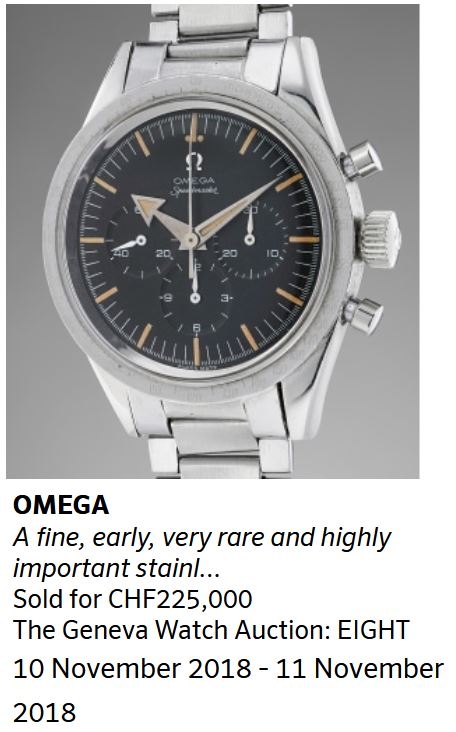
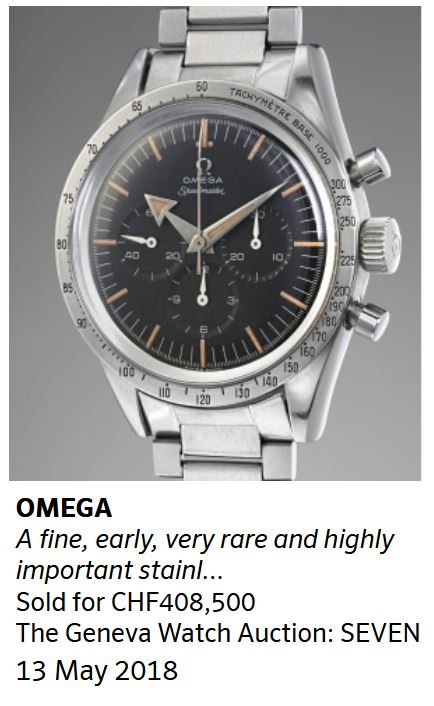
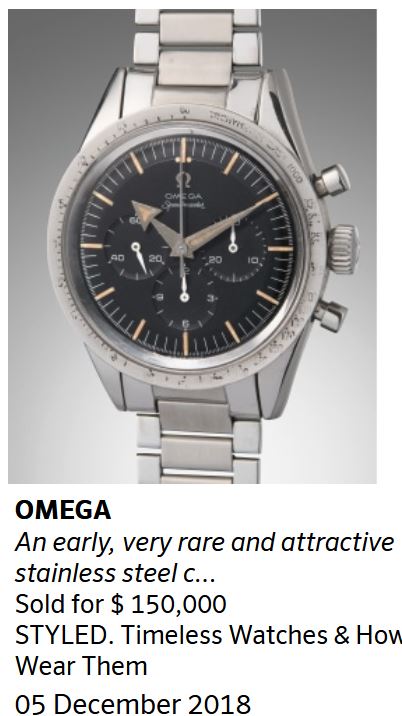
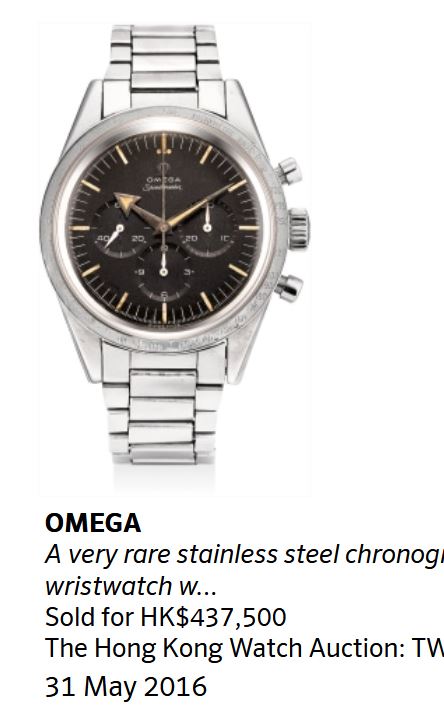
Lot 209
Ref. 145.022-69
A very well-preserved stainless steel chronograph wristwatch with pulsometer scale, bracelet, Guarantee and box
1970
40mm Diameter
Case, dial, movement and clasp signed
Estimate
CHF10,000 – 15,000
€9,300-13,900
$10,700-16,100
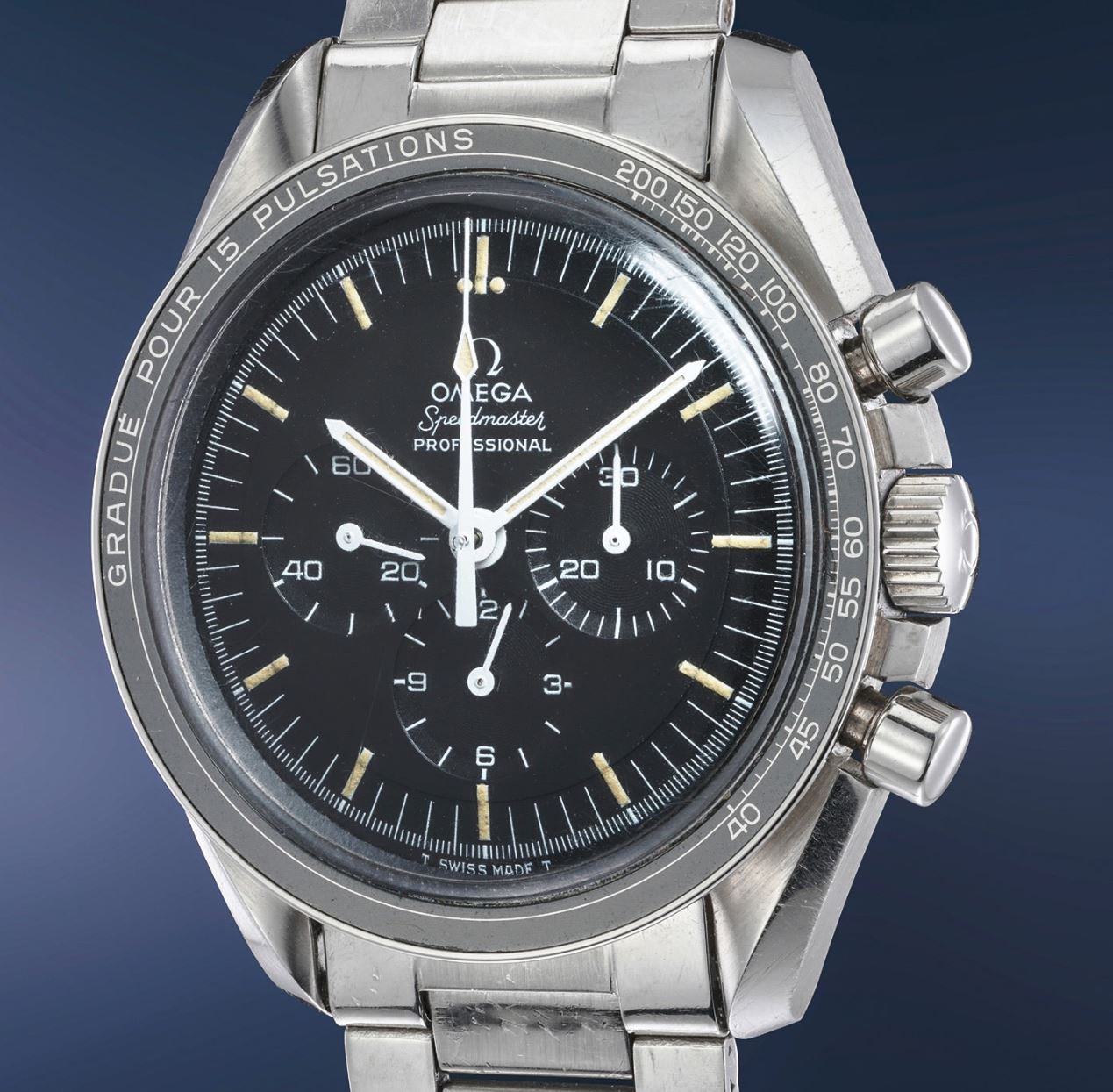
Immediately we see an unusual faded grey pulsation bezel. It has the line running around the inner quarter separating the markers from the numbers, and this is the marker we used to look for to identify the 1960s original version. Not any more, these are being reproduced.
I think this is a rather ordinary 69 stuffed into the back of the sale, possibly doing a dealer a favour. With Phillips charging 26% they are suggesting that a 145.022-69 without a valuable DO90 bezel is worth up to $20,286 which is absurd.
I am not going to waste much effort on this watch, other than to point out a little about the bezel. If this is an old 1960s bezel, then it has managed to be exposed to something that made it fade this lovely even grey, while suffering no other surface damage at all. Not only that, but the steel carrier ring also looks pristine, with no marks or damage, at all. Added to the fact that very, very few original examples of 69’s with pulsations are known, it is most likely that this bezel is a modern repro, that has been bleached. Even if I am wrong, and I can be, then on what planet does this bezel have a value beyond $1000 to $2000? Furthermore, that value is derived purely due to the fact it is a viable, correct replacement bezel for a 2998.
Look at the rest of the watch case, which shows myriad scratches and slight wear, which is absent in the bezel carrier ring. Look also at the crystal, which has many surface scratches. Look at the bracelet endlinks, which look like they have been bitten by a dog. How did the bezel come through that unscathed?
It could be that I am missing something here, or that Phillips are convinced this watch had a pulsation bezel from new, which is unusual and rare. It does after all have a full set of paperwork. Even so, I cannot see how the low estimate is justified.
Watch it sell and make me look like I don’t know what I am talking about.

You must be logged in to post a comment.